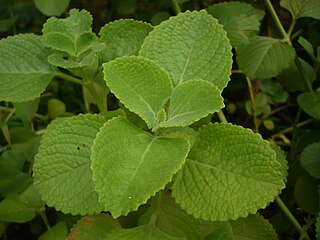
The Lamiaceae or Labiatae are a family of flowering plants commonly known as the mint or deadnettle or sage family. Many of the plants are aromatic in all parts and include widely used culinary herbs like basil, mint, rosemary, sage, savory, marjoram, oregano, hyssop, thyme, lavender, and perilla, as well as other medicinal herbs such as catnip, salvia, bee balm, wild dagga, and oriental motherwort. Some species are shrubs, trees, or, rarely, vines. Many members of the family are widely cultivated, not only for their aromatic qualities, but also their ease of cultivation, since they are readily propagated by stem cuttings. Besides those grown for their edible leaves, some are grown for decorative foliage. Others are grown for seed, such as Salvia hispanica (chia), or for their edible tubers, such as Plectranthus edulis, Plectranthus esculentus, Plectranthus rotundifolius, and Stachys affinis. Many are also grown ornamentally, notably coleus, Plectranthus, and many Salvia species and hybrids.

Brazoria County is a county in the U.S. state of Texas. As of the 2010 census, the population of the county was 313,166. The county seat is Angleton.

Solenostemon is a former genus of flowering plants in the family Lamiaceae. It has been included in the genus Plectranthus, but is now included in an expanded Coleus. They are native to tropical Africa, Asia and Australia. Some species formerly placed in this genus are cultivated for their highly variegated leaves.

Bailey's Prairie is a village in Brazoria County in the southeastern portion of the U.S. state of Texas. The population was 727 at the time of the 2010 U.S. census. Established in 1818, the village is named for the pioneer James Briton "Brit" Bailey (1779–1832).

Jones Creek is a village in Brazoria County, Texas, United States. The population was 2,020 at the 2010 census. It is the first location in Texas where Stephen F. Austin settled.
Brazoria is a name for a number of things

The Western Gulf coastal grasslands are a subtropical grassland ecoregion of the southern United States and northeastern Mexico. It is known in Louisiana as the "Cajun Prairie", Texas as "Coastal Prairie," and as the Tamaulipan pastizal in Mexico.

Area code 979 is a telephone area code in the North American Numbering Plan (NANP) for the U.S. state of Texas. The numbering plan area comprises the region generally following the Brazos River found between the Austin and Houston metro areas and its surrounding communities, stretching from just south of Waco to the Gulf Coast. It was created on February 13, 2000, in a split from area code 409.
Stephen W. Perkins was an American political figure in the Republic of Texas and early statehood Texas who, in 1846–47, served as Speaker of the Texas House of Representatives during the First Texas Legislature.

Coleus scutellarioides, commonly known as coleus, is a species of flowering plant in the family Lamiaceae, native to southeast Asia through to Australia. Typically growing to 60–75 cm (24–30 in) tall and wide, it is a bushy, woody-based evergreen perennial, widely grown for the highly decorative variegated leaves found in cultivated varieties. Another common name is painted nettle, reflecting its relationship to deadnettles, which are in the same family. The synonyms Coleus blumei, Plectranthus scutellarioides and Solenostemon scutellarioides are also widely used for this species.

Hyptis alata, the musky mint or clustered bushmint, is a shrub species of flowering plant in the Lamiaceae, the mint family. The genus Hyptis is commonly known as the bushmints. It is a native species throughout the southeastern United States from Texas to North Carolina, as well as in Cuba, Argentina, southern Brazil, and Paraguay. It is found in wetlands, prairies, pond margins and wet flatwoods. Hyptis alata is the southeastern United States analog to the Southwestern deserts H. emoryi, the Desert Lavender.USDA: NRCS: Plants Profile Hyptis alata
- Hyptis alata subsp. alata - United States and Cuba
- Hyptis alata subsp. rugosula(Briq.) Harley - South America
James Franklin Perry (1790–1853) was an American who was an early settler and prominent citizen of Texas. James married to Emily Austin Perry, and together they operated Peach Point Plantation. He was involved in Texas land distribution.
Barton Holland Warnock (1911–1998) was an American botanist and leading authority on flora of the Trans-Pecos area and northern Chihuahua Desert.

Coleus is a genus of annual or perennial herbs or shrubs, sometimes succulent, sometimes with a fleshy or tuberous rootstock, found in the Old World tropics and subtropics. The relationship among the genera Coleus, Solenostemon and Plectranthus has been confused. Coleus and Solenostemon were sunk into Plectranthus, but recent phylogenetic analysis found Plectranthus to be paraphyletic with respect to other related genera in the subtribe Plectranthinae. The most recent taxonomic treatment of the genus resurrected Coleus, and 212 names were changed from combinations in Plectranthus, Pycnostachys and Anisochilus. Equilabium was segregated from Plectranthus, after phylogenetic studies supported its recognition as a phylogenetically distinct genus.

Brazoria is a genus of plants in the family Lamiaceae, first described in 1845. It contains three known species, all endemic to the US state of Texas.
Brazoria arenaria, common name sand Brazos-mint, is a plant in the family Lamiaceae, first described in 1945. It is endemic to southern Texas.
Brazoria enquistii is a plant species in the family Lamiaceae. It is a rare plant known only from three counties in central Texas.

Brazoria truncata, common name rattlesnake flower, is a plant species in the family Lamiaceae, first described in 1834. It is endemic to Texas, found in the south-central and eastern parts of the state.
Hoehnea is a genus of plants in the family Lamiaceae, first described with this name in 1939. It is native to South America, primarily southern Brazil.

Lamioideae is a subfamily of plants in the family Lamiaceae.











